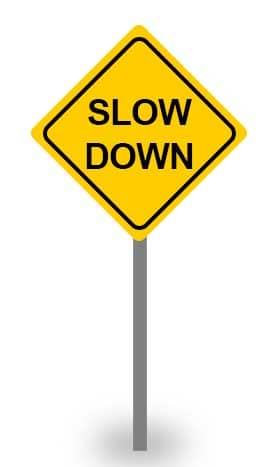Slow Down – “Speed Kills”
 While I may not always succeed in creating great photos one of my objectives is to try to make every photo a great one. I believe that the difference between a great photo and a merely good photo is in the details. It’s doing all the little things right. It’s putting in the extra effort rather than settling for “good enough”. I challenge myself to make sure I do everything I’m capable of to create a great photo. Strangely, I find the hardest obstacle to overcome is seemingly one of the easiest. It’s all about remembering to slow down and calmly do all that is needed to create the opportunity for a great photograph.
While I may not always succeed in creating great photos one of my objectives is to try to make every photo a great one. I believe that the difference between a great photo and a merely good photo is in the details. It’s doing all the little things right. It’s putting in the extra effort rather than settling for “good enough”. I challenge myself to make sure I do everything I’m capable of to create a great photo. Strangely, I find the hardest obstacle to overcome is seemingly one of the easiest. It’s all about remembering to slow down and calmly do all that is needed to create the opportunity for a great photograph.
Photography isn’t a race. Instagram and Facebook will still be there tomorrow. You can’t lose sight of your objective for the sake of speed. For my style of photography (and most people’s too) there is no urgent reason to rush through anything. I still struggle with this concept. There have been a number of times where a particular situation has been challenging and it was only later when I got home that way to handle it became clear. I knew along what I should have done. Instead I let myself get caught up in the perceived urgency of the moment and missed the opportunity. All I really had to do was to slow down and calmly reflect on the best way to handle the situation.
Why Is This So Hard?
In the pre-digital days, we were forced to be slower. Each shot had a real cost to it; we had to make each one count. So we took the time to get it right; no burst mode (even if you could afford a camera with a motor drive). Once we were done shooting the slow down continued. If we had half a roll left in the camera the photos may have waited weeks before we could finish the roll and get them developed. Developing and printing could also be very time consuming. Speed was simply not an option.
The digitization of photography gear and post-processing along with the internet has changed all that. Now we shoot, publish and post in a matter of minutes. Just because we can be speedy it doesn’t mean we should be. In some regard, quality is sacrificed for the sake of speed. The old highway safety slogan (and later anti-drug slogan), “Speed Kills” comes to mind.
Start By Lowering The Anxiety Level
Part of the frenetic pace is a result of just showing up and taking shots willy-nilly. Oh, that looks cool, click. Oh, I have to hurry and change lenses. We run around without direction snapping photos. As we do this the anxiety builds that we might miss something and we react by speeding up to get things done.
Before you go out spend some time thinking about what you will be doing. What kind of setup (lenses, settings etc.) do you think you’ll need? What challenges might you face and how could you address them? Do some research to plan your shot. Look at other people’s photos, use Google Street View to look at sightlines and the overall scene. As the old saying goes, “Plan your work and work your plan.”
Include an allowance for flexibility and exploration into the plan. Things don’t always (or should I say usually) go as planned but knowing that your plan has an allowance for that is a calming factor that allows you to slow down and concentrate.
Take A Deep Breath
When you arrive on scene don’t start shooting immediately. Take a few minutes and drink it all in. Enjoy the moment, explore a little bit. Relax, this is supposed to fun after all. Now start working your plan, confident you know what you’re doing and have made an allowance for the unexpected. Work it in a methodical, deliberate manner so you don’t miss any of the steps.
A Word About Tripods
If the scene and subject matter allow the use of tripods take advantage of the situation and use one. We all know the technical reasons. A tripod can help keep an image sharp by reducing vibration and movement. It’s tempting to rely on image stabilization. It’s good, but why rely on good enough when it could be better. The downside is that it can be a pain to set up and slow you down which is exactly the point of my argument (the slow you down part, not the pain). Using a tripod allows us concentrate on the composition, position the subject, place the leading lines and review for distractions along the edges. It allows us to be consistent from shot to shot which is especially nice when exposure bracketing. It gives us time to think about what we’re doing!
Let Them Marinate
Okay, you’re done shooting so you race home, jump on the computer, process the photos and publish them within minutes or hours. I’d recommend you not do this. Sure, go ahead and back them up on your computer. It’s okay to take a quick peek too (the curiosity would kill you otherwise). Then stop! I recommend you wait another 2 or 3 days minimum before starting your processing. Let them marinate as it were.
The reason I suggest this is that we are too emotionally invested in the images immediately after taking them. We need some time after taking them to be able to review and judge them objectively. The “can’t see the forest for the trees” syndrome kicks during this period. We miss things. It’s not too uncommon to look at a photo a few days after we took and processed it immediately and be surprised to find sensor spots and other flaws. We wonder how we could have missed it as they now seem obvious. It’s our emotional investment in the photo that blinds us to the flaws.
And Marinate A Second Time
So, after waiting the 2 or 3 days to process them you publish as soon as your done processing. Not so fast, my friend. I suggest a bit more “marinating”. The reasons are the same. We need to be able to objectively evaluate both the photo and our processing before finally presenting it to the world.
A Final Crazy Tip
If you struggle with remembering to slow down here’s an off the wall suggestion. Just sing or hum Paul Simon’s The 59th Street Bridge Song (Feelin’ Groovy).
Slow down, you move too fast
You got to make the morning last
Just kicking down the cobble stones
Looking for fun and feelin’ groovyBa da, da, da, da, da, da
Feelin’ groovy
A word of warning. You don’t have to hum or sing this out loud. Just hum or sing it to yourself. Otherwise people may look at you a little funny – just sayin’.
Do you think you need to slow down? What do you do to slow down? Please leave a comment in the comment box below.

